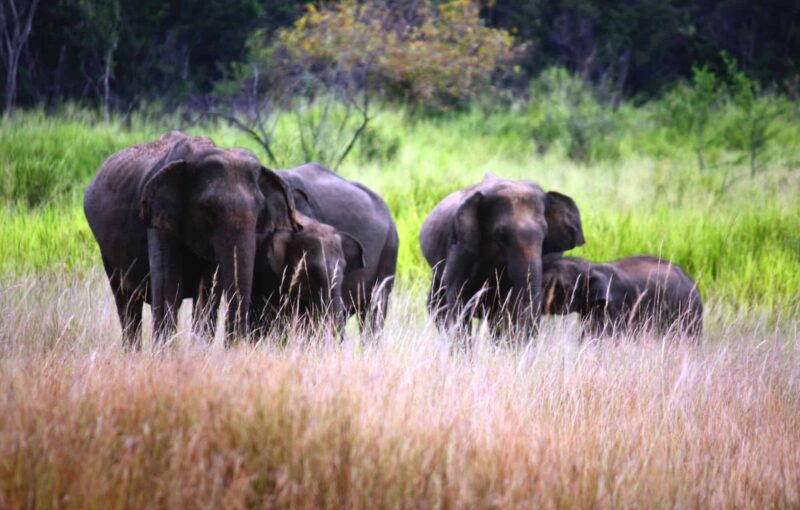The jungle village of Nabadegaswewa in Sri Lanka serves as an important buffer zone in the local ecosystem and is home to two watersheds – the Manamperi and Katuwewa tanks — which are the main source of water for the area. It is also a safe-haven for wildlife, such as elephants.
But in December 2016, the country’s Road Development Authority (RDA) began clearing the forest using heavy machinery, saying it had obtained permission from the Mahaweli Authority (MA) to acquire four acres of land in Nabadegaswewa “free of trees.” Families living in the area say they weren’t notified that their land would be seized, and both the RDA and MA local officials said the forest clearing activity did not require an environmental impact assessment.
A similar type of environmental destruction arose in Gommunnawa mountain range after a private company began forest clearing without conducting an impact assessment.
Like Nabadagaswewa, Gommunnawa serves as the main watershed for the Deduru-oya River. Along its left bank, the river feeds 37 main tanks. On its right bank, it feeds a 75-million cubic meter spill-level capacity reservoir, which provides water for 27,000 acres of irrigable land upon which 11,500 farming families depend.
But the area has come under pressure following a decision by the Geological Survey and Mines Bureau to grant permission to a private company to clear 225 acres of forest land and run a quarry and timber saw mill there.
Journalist Prasanna Cooray, a member of EJN’s large network, decided to bring attention to these cases, publishing a story about the destruction of the forest reserve in Nabadegaswewa and its ecological significance in Sri Lanka’s daily newspaper The Island in January 2017. His stories about the situation in Gommunnawa appeared in March and July of the same year.
“When we informed him about the forest destruction in Nabadegaswewa he immediately wrote about it. He also contacted the government officials responsible and published their versions,” Ven. Wekadawela Rahula Thera, an activist with the Centre for Environment and Nature Studies who led a campaign to protect the forest, told EJN.
Two months after the story appeared, Thera reported that the forest destruction had stopped.
“When the article was published it received lot of attention, and the higher officials took immediate steps to halt the forest destruction,” said Thera.
“The responsible officials were transferred out from that office. The timely intervention saved the wildlife and also prevented a possible human-elephant conflict that could have happened if the forest was further cut,” he added.
The response took longer in Gommunnawa, where the government withdrew the quarry company’s operating permit after more than a year and a half, following the ruling of a court case in which Cooray said his articles were presented as evidence. Intense campaigning by the villagers, who had filed the case under the public nuisance ordinance to stop the company’s activities, also played a role in the government’s decision, he said.
“My writings gave strength to the local communities, who were given a sense [that] their voices were heard and are being recognized,” Cooray said, noting that conversations emerged both within the communities on a face-to-face basis as well as through social media, helping spread the issue far beyond the effected villages.
Not only did public response and debate occur in the communities, but also among government officials at both the local and national level, said Cooray.
The villagers are now waiting to win back access to the road claimed by the company following a resolution that the local council passed in their favour.
That could still take a few months, but Cooray has called the outcome a “great victory” for the villagers, who have stood together in the battle and also “a very rare situation in this country.”
Ruwan K Kulugammana, director of the Sri Lanka Wild Orchid Centre and national coordinator for Gmata Hetak Environmental Organization, confirmed that Cooray had visited the village and that his articles were filed as part of the court case. “Now the whole project is closed down and we can sleep peacefully knowing that the mountain is not going to come down on us at night.”
Cooray was granted the Best Environment Journalist of the Year award in 2017 by the Sri Lanka Press Institute and the Editors’ Guild and is currently working on a book on environmental governance that revisits issues he has covered in the past. A registered member of EJN, he says he’s found the site helps update his knowledge on what’s happening around the world.
“Things are changing little by little,” Cooray says.
(Banner photo: Sri Lanka Elephants in Maduru Oya National Park. Credit:Anton Croos/CC)
